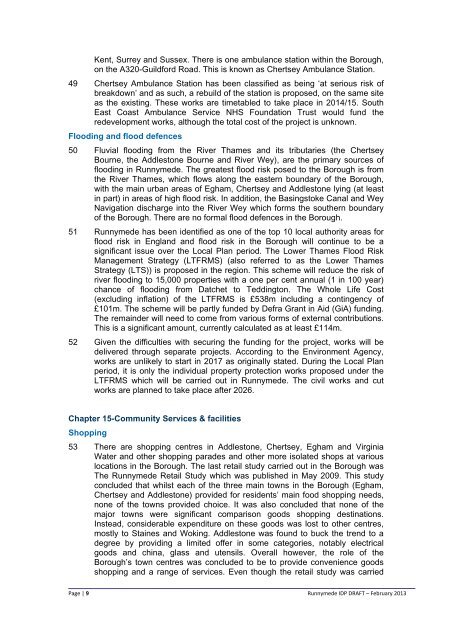Infrastructure Delivery Plan (Feb 2013) - Runnymede Borough Council
Infrastructure Delivery Plan (Feb 2013) - Runnymede Borough Council
Infrastructure Delivery Plan (Feb 2013) - Runnymede Borough Council
Create successful ePaper yourself
Turn your PDF publications into a flip-book with our unique Google optimized e-Paper software.
Kent, Surrey and Sussex. There is one ambulance station within the <strong>Borough</strong>,<br />
on the A320-Guildford Road. This is known as Chertsey Ambulance Station.<br />
49 Chertsey Ambulance Station has been classified as being ‘at serious risk of<br />
breakdown’ and as such, a rebuild of the station is proposed, on the same site<br />
as the existing. These works are timetabled to take place in 2014/15. South<br />
East Coast Ambulance Service NHS Foundation Trust would fund the<br />
redevelopment works, although the total cost of the project is unknown.<br />
Flooding and flood defences<br />
50 Fluvial flooding from the River Thames and its tributaries (the Chertsey<br />
Bourne, the Addlestone Bourne and River Wey), are the primary sources of<br />
flooding in <strong>Runnymede</strong>. The greatest flood risk posed to the <strong>Borough</strong> is from<br />
the River Thames, which flows along the eastern boundary of the <strong>Borough</strong>,<br />
with the main urban areas of Egham, Chertsey and Addlestone lying (at least<br />
in part) in areas of high flood risk. In addition, the Basingstoke Canal and Wey<br />
Navigation discharge into the River Wey which forms the southern boundary<br />
of the <strong>Borough</strong>. There are no formal flood defences in the <strong>Borough</strong>.<br />
51 <strong>Runnymede</strong> has been identified as one of the top 10 local authority areas for<br />
flood risk in England and flood risk in the <strong>Borough</strong> will continue to be a<br />
significant issue over the Local <strong>Plan</strong> period. The Lower Thames Flood Risk<br />
Management Strategy (LTFRMS) (also referred to as the Lower Thames<br />
Strategy (LTS)) is proposed in the region. This scheme will reduce the risk of<br />
river flooding to 15,000 properties with a one per cent annual (1 in 100 year)<br />
chance of flooding from Datchet to Teddington. The Whole Life Cost<br />
(excluding inflation) of the LTFRMS is £538m including a contingency of<br />
£101m. The scheme will be partly funded by Defra Grant in Aid (GiA) funding.<br />
The remainder will need to come from various forms of external contributions.<br />
This is a significant amount, currently calculated as at least £114m.<br />
52 Given the difficulties with securing the funding for the project, works will be<br />
delivered through separate projects. According to the Environment Agency,<br />
works are unlikely to start in 2017 as originally stated. During the Local <strong>Plan</strong><br />
period, it is only the individual property protection works proposed under the<br />
LTFRMS which will be carried out in <strong>Runnymede</strong>. The civil works and cut<br />
works are planned to take place after 2026.<br />
Chapter 15-Community Services & facilities<br />
Shopping<br />
53 There are shopping centres in Addlestone, Chertsey, Egham and Virginia<br />
Water and other shopping parades and other more isolated shops at various<br />
locations in the <strong>Borough</strong>. The last retail study carried out in the <strong>Borough</strong> was<br />
The <strong>Runnymede</strong> Retail Study which was published in May 2009. This study<br />
concluded that whilst each of the three main towns in the <strong>Borough</strong> (Egham,<br />
Chertsey and Addlestone) provided for residents’ main food shopping needs,<br />
none of the towns provided choice. It was also concluded that none of the<br />
major towns were significant comparison goods shopping destinations.<br />
Instead, considerable expenditure on these goods was lost to other centres,<br />
mostly to Staines and Woking. Addlestone was found to buck the trend to a<br />
degree by providing a limited offer in some categories, notably electrical<br />
goods and china, glass and utensils. Overall however, the role of the<br />
<strong>Borough</strong>’s town centres was concluded to be to provide convenience goods<br />
shopping and a range of services. Even though the retail study was carried<br />
Page | 9 <strong>Runnymede</strong> IDP DRAFT – <strong>Feb</strong>ruary <strong>2013</strong>
















